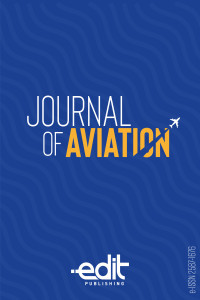Air-traffic Flow Prediction with Deep Learning: A Case Study for Diyarbakır Airport
Air-traffic Flow Prediction with Deep Learning: A Case Study for Diyarbakır Airport
___
- Aygun, H., Dursun, O. O., & Toraman, S. (2023). Machine learning based approach for forecasting emission parameters of mixed flow turbofan engine at high power modes. Energy, 271(January), 127026.
- Bakreen, S., Markovskaya, E., Merzlikin, I., & Mottaeva, A. (2022). Development of the approach to the analysis of aviation industry’s adaptation to seasonal disruptions. Transportation Research Procedia, 63, 1431–1443.
- Bombelli, A., Santos, B. F., & Tavasszy, L. (2020). Analysis of the air cargo transport network using a complex network theory perspective. Transportation Research Part E: Logistics and Transportation Review, 138(April), 101959.
- Dalmau, R. (2022). Predicting the likelihood of airspace user rerouting to mitigate air traffic flow management delay. Transportation Research Part C: Emerging Technologies, 144(August), 103869.
- DHMİ. (n.d.). DHMİ. Retrieved December 13, 2016, from http://www.dhmi.gov.tr/istatistik.aspx
- Di Gravio, G., Mancini, M., Patriarca, R., & Costantino, F. (2015). Overall safety performance of Air Traffic Management system: Forecasting and monitoring. Safety Science, 72, 351–362.
- Dursun, Ö. O., & Toraman, S. (2021). Uzun Kısa Vadeli Bellek Yöntemi ile Havayolu Yolcu Tahmini. Journal of Aviation, 5(1), 241–248.
- Guo, J., Lao, Z., Hou, M., Li, C., & Zhang, S. (2021). Mechanical fault time series prediction by using EFMSAE-LSTM neural network. Measurement: Journal of the International Measurement Confederation, 173 (October 2020), 108566.
- Jiang, W., & Luo, J. (2022). Graph neural network for traffic forecasting: A survey. Expert Systems with Applications, 207(December 2021), 117921.
- Jo, A. H., & Chang, Y. T. (2023). The effect of airport efficiency on air traffic, using DEA and multilateral resistance terms gravity models. Journal of Air Transport Management, 108(January), 102364.
- Kızrak, M. A., & Bolat, B. (2019). Uçak Motoru Sağlığı için Uzun-Kısa Süreli Bellek Yöntemi ile Öngörücü Bakım. Bilişim Teknolojileri Dergisi, 103–109.
- Kotegawa, T., DeLaurentis, D. A., & Sengstacken, A. (2010). Development of network restructuring models for improved air traffic forecasts. Transportation Research Part C: Emerging Technologies, 18(6), 937–949.
- Li, X., & Zhao, Y. (2023). Evaluation of sound environment in departure lounges of a large hub airport. Building and Environment, 232(January).
- Méndez, M., Merayo, M. G., & Núñez, M. (2023). Long-term traffic flow forecasting using a hybrid CNN-BiLSTM model. Engineering Applications of Artificial Intelligence, 121(March), 106041.
- Mondoloni, S., & Rozen, N. (2020). Aircraft trajectory prediction and synchronization for air traffic management applications. Progress in Aerospace Sciences, 119(20).
- Shakeel, A., Tanaka, T., & Kitajo, K. (2020). Time-series prediction of the oscillatory phase of eeg signals using the least mean square algorithm-based ar model. Applied Sciences (Switzerland), 10(10).
- Solvoll, G., Mathisen, T. A., & Welde, M. (2020). Forecasting air traffic demand for major infrastructure changes. Research in Transportation Economics, 82(September 2019), 100873.
- Song, X., Liu, Y., Xue, L., Wang, J., Zhang, J., Wang, J., Cheng, Z. (2020). Time-series well performance prediction based on Long Short-Term Memory (LSTM) neural network model. Journal of Petroleum Science and Engineering, 186(November 2019), 106682.
- Standfuss, T., Fricke, H., & Whittome, M. (2022). Forecasting European Air Traffic Demand - How deviations in traffic affect ANS performance. Transportation Research Procedia, 59, 105–116.
- Tanrıverdi, G., Ecer, F., & Durak, M. Ş. (2022). Exploring factors affecting airport selection during the COVID-19 pandemic from air cargo carriers’ perspective through the triangular fuzzy Dombi-Bonferroni BWM methodology. Journal of Air Transport Management, 105(June).
- Tascón, D. C., & Díaz Olariaga, O. (2021). Air traffic forecast and its impact on runway capacity. A System Dynamics approach. Journal of Air Transport Management, 90(September 2020).
- Yayın Aralığı: Yılda 3 Sayı
- Başlangıç: 2017
- Yayıncı: Vedat Veli ÇAY
Measurement of Process-Performances of Turkish Airports Using Network Data Envelopment Analysis
Innovative Morphing UAV Design and Manufacture
Air-traffic Flow Prediction with Deep Learning: A Case Study for Diyarbakır Airport
Filiz MIZRAK, Gonca Reyhan AKKARTAL
The Importance of Periodic Oral and Dental Health Examination of Aircrew
Gürkan Raşit BAYAR, Güneş SANAL, Dr. Öğr. Üyesi Şükrü Hakan GÜNDÜZ, Abdurrahman Engin DEMİR
Design and Simulation of a Conformal Micro-Strip Patch Antenna at GNSS L1/ E1 Frequency Band
Kazım Buğra GÜRBÜZ, Mustafa TAŞKIN
Stock Price Prediction with Box-Jenkins Models: Delta Airlines Application
A PESTEL Analysis of The Impacts of COVID-19 Crisis on Air Transportation Sector's Future
